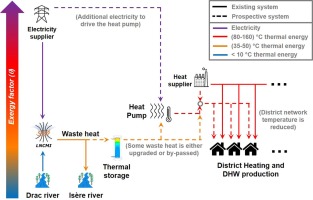当前位置:
X-MOL 学术
›
Energy Convers. Manag.
›
论文详情
Our official English website, www.x-mol.net, welcomes your
feedback! (Note: you will need to create a separate account there.)
Energy- and exergy-based optimal designs of a low-temperature industrial waste heat recovery system in district heating
Energy Conversion and Management ( IF 9.9 ) Pub Date : 2020-05-01 , DOI: 10.1016/j.enconman.2020.112753 Jaume Fitó , Sacha Hodencq , Julien Ramousse , Frédéric Wurtz , Benoit Stutz , François Debray , Benjamin Vincent
Energy Conversion and Management ( IF 9.9 ) Pub Date : 2020-05-01 , DOI: 10.1016/j.enconman.2020.112753 Jaume Fitó , Sacha Hodencq , Julien Ramousse , Frédéric Wurtz , Benoit Stutz , François Debray , Benjamin Vincent

|
Abstract This paper illustrates how the choice of indicators changes the design of a waste heat recovery system in district heating. A prospective system in Grenoble (France) aims to valorize waste heat from the French National Laboratory of Intense Magnetic Fields (LNCMI) by injecting it at 85 °C to the nearby district heating network. We optimize its design for three possible waste heat temperatures: 35 °C (current), 50 °C (viable) and 85 °C (innovative). As major components, the system includes a thermal storage (ranging from 10 MWh to 40 MWh) and may include a heat pump depending on the waste heat’s temperature. Different optimizations are guided by two energetic indicators (one source-oriented, the other demand-oriented) and by the overall exergy efficiency. The system’s annual performance is assessed through the Sankey and Grassman diagrams and compared between optimal designs. Yearly simulation included optimal management of the thermal storage, through mixed-integer linear programming. The demand-oriented optimal design suggests recovering waste heat at 35 °C with a heat pump and a 40-MWh storage, granting the highest coverage of residential needs (49%). On the other hand, the source-oriented optimal design suggests recovering waste heat at 85 °C without heat pump and with a 40-MWh storage, reaching the highest recovery of waste heat (55%). Exergy analysis supports the source-oriented design, as it reaches the highest global exergy efficiency (27%). Our prospective techno-economic and exergo-economic analyses should complement these results and may change some conclusions, especially regarding the storage capacity.
中文翻译:

基于能量和火用的区域供热低温工业余热回收系统优化设计
摘要 本文阐述了指标的选择如何改变区域供热余热回收系统的设计。位于法国格勒诺布尔的一个前瞻性系统旨在通过将 85°C 的法国国家强磁场实验室 (LNCMI) 的废热注入附近的区域供热网络,从而使废热增值。我们针对三种可能的废热温度优化其设计:35 °C(当前)、50 °C(可行)和 85 °C(创新)。作为主要组件,该系统包括一个蓄热器(从 10 MWh 到 40 MWh),并且可能包括一个热泵,具体取决于废热的温度。不同的优化由两个能量指标(一个以资源为导向,另一个以需求为导向)和整体火用效率指导。系统的年度性能通过 Sankey 和 Grassman 图进行评估,并在最佳设计之间进行比较。年度模拟包括通过混合整数线性规划对热存储进行优化管理。以需求为导向的优化设计建议使用热泵和 40 MWh 存储回收 35 °C 的废热,从而最大程度地满足住宅需求 (49%)。另一方面,面向源的优化设计建议在没有热泵和40MWh存储的情况下回收85°C的废热,达到最高的废热回收率(55%)。火用分析支持面向源的设计,因为它达到了最高的全局火用效率 (27%)。我们前瞻性的技术经济和运动经济分析应该补充这些结果,并可能改变一些结论,
更新日期:2020-05-01
中文翻译:

基于能量和火用的区域供热低温工业余热回收系统优化设计
摘要 本文阐述了指标的选择如何改变区域供热余热回收系统的设计。位于法国格勒诺布尔的一个前瞻性系统旨在通过将 85°C 的法国国家强磁场实验室 (LNCMI) 的废热注入附近的区域供热网络,从而使废热增值。我们针对三种可能的废热温度优化其设计:35 °C(当前)、50 °C(可行)和 85 °C(创新)。作为主要组件,该系统包括一个蓄热器(从 10 MWh 到 40 MWh),并且可能包括一个热泵,具体取决于废热的温度。不同的优化由两个能量指标(一个以资源为导向,另一个以需求为导向)和整体火用效率指导。系统的年度性能通过 Sankey 和 Grassman 图进行评估,并在最佳设计之间进行比较。年度模拟包括通过混合整数线性规划对热存储进行优化管理。以需求为导向的优化设计建议使用热泵和 40 MWh 存储回收 35 °C 的废热,从而最大程度地满足住宅需求 (49%)。另一方面,面向源的优化设计建议在没有热泵和40MWh存储的情况下回收85°C的废热,达到最高的废热回收率(55%)。火用分析支持面向源的设计,因为它达到了最高的全局火用效率 (27%)。我们前瞻性的技术经济和运动经济分析应该补充这些结果,并可能改变一些结论,











































 京公网安备 11010802027423号
京公网安备 11010802027423号